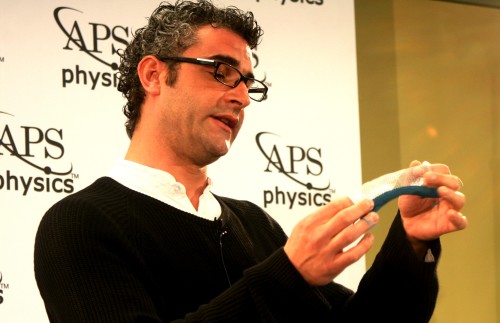
Knit stitch: Frédéric Lechenault talks about the physics of knitted materials. (Courtesy: James Riordon/APS)
By Tushna Commissariat in Baltimore, Maryland, US
You may think that a simple occurrence such as a tree shedding its leaves or an everyday activity such as knitting or ribbon-curling does not involve a great deal of physics, but you would be wrong. In a press session here at the APS March meeting entitled “The physics of everyday life”, three different groups of researches talked about the unexpectedly complex physical principles that govern all of the above mentioned instances.
Sunny Jung of the Bio-Inspired Fluid Lab at Virginia Tech in the US studies the shapes of different leaves and the thickness of their “petioles” or stalks – both of which determine the stresses a leaf can withstand on a windy day and what happens when it ultimately falls. Jung’s team studies this because leaves are actually very good at withstanding all kinds of stress and strain without buckling – something that could be applied to large man-made industrial objects such as suspended road-signs.
The researchers found that slender leaves are more likely to bend under high winds, whereas a flat leaf is more likely to twist at the stem before falling. They also discovered that the length of the stalk is determined by the size of the leaf, with larger leaves needing longer stems so that sunlight can cover more of their surface area.
Anne Juel of the University of Manchester in the UK, meanwhile, helped us all become better present wrappers with her talk on the physics of “ribbon curling”. If you are not sure how exactly those bouncy spiral ribbons are created, its easy – run a length of ribbon across a sharpened blade of scissor and watch it curl.
While it sounds easy enough, Juel explained that the physical mechanisms that cause the curling have yet to be quantitatively explained. Jule and colleagues worked towards this by developing a theoretical model to identify factors that optimize curling and clarify the process.
They found that sharper blades create tighter curls if you don’t pull the ribbon too hard, while blunt blades do the reverse. They also found that blades of different thickness exhibit a threshold load (the amount of force you exert while pulling) for the onset of curling and that most curling occurs at an intermediate load, when you don’t pull with too much force or too gently. Juel told us that one of the main aims of the group was to gain new insights into the science of “yielding” using a combination of experiment and theory.
Finally, Frédéric Lechenault and Samuel Poincloux of the Laboratory of Statistical Physics at the CNRS in France talked about the surprisingly complicated mechanics that determines the underlying fundamental framework of knitted fabrics. Using an extremely simple fabric knitted using fishing line (thereby avoiding the frictional dynamics that come into play with yarn that has a texture and tension) pictured above, the researchers developed a mechanical model based on the correlations between geometry and energy of the system. Their aim was to quantitatively study the mechanical response of the fabric when deformed and its general shape, while playing with its topology. The researchers hope their insights will someday help in the creation of thread-based smart materials.
The curling of ribbons is due to the “wedge effect” of the sharpened edge of a scissor or a knife that destroys the balance of opposing forces on both sides of the ribbon. In the case, where the wedge effect is too strong or too weak, it is obvious that the ribbon will not curl.
Trackback: Blog - physicsworld.com